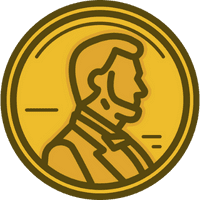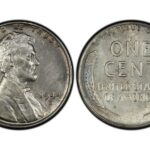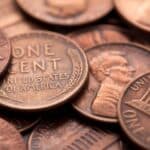Have you recently come across an old 1935 one-dollar bill? Then, you probably want to know how much it’s worth.
Buckle up because you’re in for a ride.
The 1935 $1 bill is a significant piece of American history. Unlike today’s Federal Reserve Notes, this note was backed by silver, meaning you could redeem it for an equal amount of the precious metal. Hence, the name 1935 silver certificate dollar bills.
Despite their significance, 1935-dollar notes are not rare, and most are worth only their face value of $1. However, some unique varieties and error notes are highly collectible and valuable to currency enthusiasts and numismatics.
Do you want to explore the 1935 one-dollar bill further? Continue reading below…
The History Behind the 1935 Dollar Bill
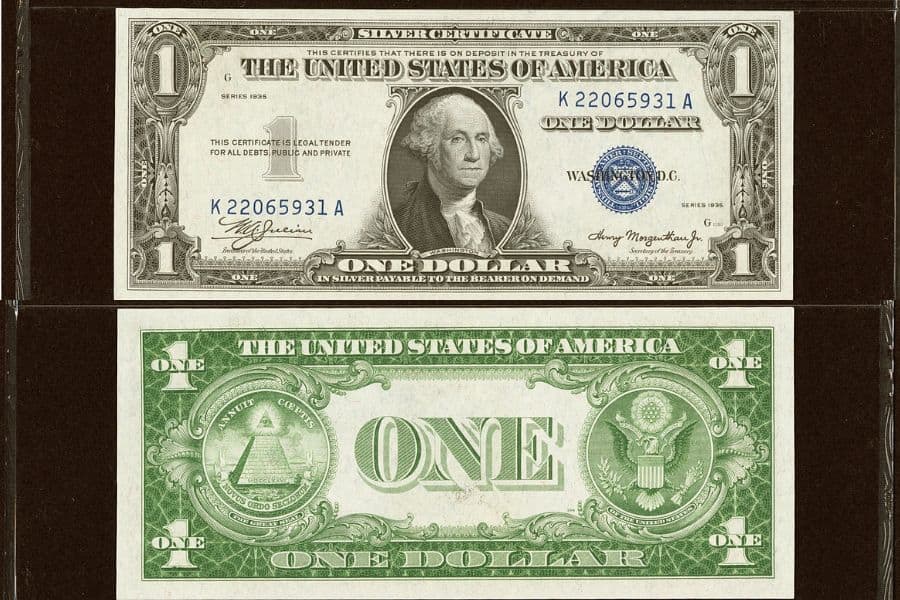
Issued between 1935 and 1957, the 1935 $1 bill came into the light during the Great Depression. The economic shock forced people into hoarding and melting coins containing precious metals like silver.
This led to shortages of coins and volatile price fluctuations. To prevent currency gaps, the government introduced dollar bills backed by silver coins, popularly known as silver certificates.
Having a silver certificate meant that you could exchange the notes for silver coins on demand. Later (from 1967 to 1968), people could redeem the bills for raw silver bullion or silver granules.
While people did not use these notes for all transactions, they were more convenient. How?
They could carry them easily in their pockets compared to silver dollar coins.
Similar to modern paper currency, the date on these didn’t always reflect the printing date, but rather a major redesign. That’s where the 1935 $1 bill comes into the picture.
It’s arguably one of the most popular silver certificates. One reason for this is its unique reverse designs, which changed from “The Funny Back” to the “All-Seeing Eyes” design, but more on this later.
The U.S. government produced around 38 billion silver certificates. Unlike silver notes from before 1928, the 1935 $1 bills were printed in small size, with dimensions of 6.14 inches x 2.61 inches.
The 1935 series lasted through the letter “H”, after which a new date appeared on the silver certificate: 1957. However, the Federal Reserve released some 1935 $1 notes as late as 1963.
In 1964, people could no longer redeem silver certificates for silver, so they phased out. But this did not stop numismatics from collecting uncommon prints with the hope of getting more than their face value.
Surprisingly, the 1935 silver certificate is still considered a valid legal tender As such, it’s acceptable as a form of currency.
1935 Dollar Bill Design
The 1935 $1bill carries several design elements that distinguish it from other small-size silver certificates. In this section, we’ll discuss the various characters and features that make up these notes. Let’s start with the obverse.
Obverse Design
On the obverse side, the 1935 one-dollar rocks a portrait of George Washington based on a painting by Gilbert Stuart. The image first appeared in U.S. currency in 1869, and even today it’s still the centerpiece on the $1 note.
The obverse also includes the words “Silver Certificate,”above the founding father. The inscription “This certifies that there is on deposit in the Treasury of the United States of America one dollar is payable to the bearer on demand” is at the top and bottom of the portrait.
Another design feature worth highlighting is the blue seal, which indicates that the note is a silver certificate.
On the bottom left and right, you will notice the signatures of the U.S. Treasurer and Secretary of the Treasury, plus the serial numbers.
Reverse Design
As for the reverse, the 1935 one-dollar note features the Great U.S. Seal. This was the first time the official seal was printed on the $1 bills, making them a legal tender.
The Great Seal includes a bald eagle with an olive branch and a cluster of arrows in its talon to symbolize peace and war. In addition, the bird carries a ribbon with the Latin motto “E Pluribus Unum” (out of many, one).
On top of it are 13 stars, which represent the original 13 colonies that make up the United States of America.
But perhaps the most captivating aspect of the reverse design is the “All-Seeing Eye” sitting above the pyramid. Below the pyramid is a banner with the motto “Novus Ordo Seclorum” which means “New order of the ages”.
1935 Dollar Bill Value Chart and Varieties
| 1935 Dollar Bill Value Chart | ||||
| Series | Circulated | Uncirculated | Grade 66 | Grade 67 |
| Regular 1935 $1 Bill | $1- $7 | $20 – $30 | $50 – $130 | $200 – $500 |
| 1935 Star Notes | $8 – $12 | $15 – $50 | $125 – $300 | $800 – $1,000 |
The table above shows how much 1935 regular bills and star notes sell for in various conditions. At circulated state, a 1935 silver certificate costs no more than one dollar.
Even in lightly circulated conditions, some coin shops will not purchase them because they have a low-profit margin. But as the condition of the bill improves, so will its value.
In a very fine state, a regular 1935 dollar can sell anywhere from $3 to $8. But those that have never entered circulation can fetch a higher premium, upwards of $30 or more.
The value of notes doubles or even triples in higher grades. For example, a regular 1935 dollar bill graded at MS–64 sold for $120 in 2021 at Heritage Auctions. Another rare piece graded at 67 by PCGS ( one of its kind) fetched $3,055 in 2013.
We will discuss the value of star notes below as we look at 1935-dollar bill varieties, including:
1. 1935 Silver Certificate Dollar Star Note Value
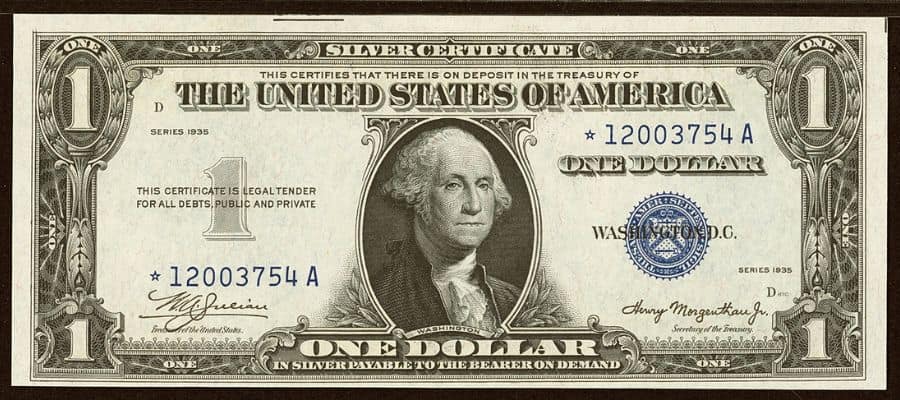
Star notes of replacement bills refer to paper currency designed to replace any bill damaged during the minting process. These notes stand out because they have an asterisk or star at the beginning of their serial number.
1935-star notes tend to be more scarce than regular one dollar, so currency collectors covet them.
In circulated conditions, the most common series star notes are valued at around $8 to $12. On the other hand, uncirculated star notes in very fine condition can sell from $15 to $50.
If the dollar note is from the 1935 series, 1935A series, and 1935B series, expect at least $100 in uncirculated condition.
For instance, a 1935B $1 star silver certificate with a grade of 65 can sell for as much as $320 on eBay.com. If the note is a 1935 plain series, it can cost about $799.
2. 1935A $1 North Africa Note
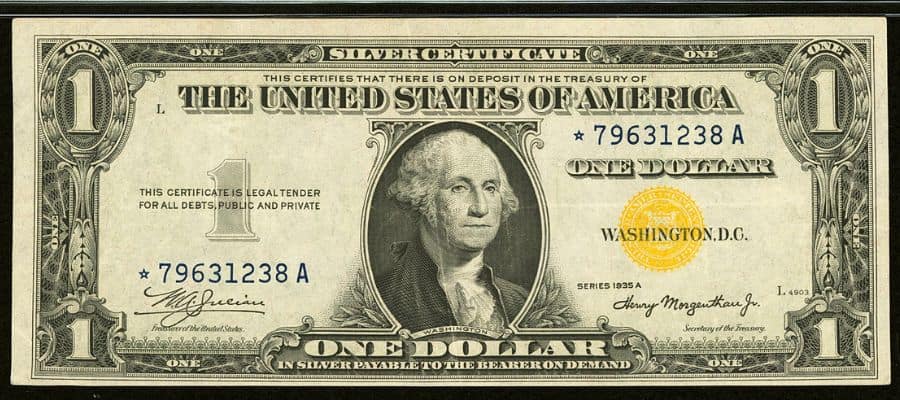
The 1935 series saw many changes in a short period with various seal sizes, ink color combinations, and signatures being adopted. This gave rise to the 1935-a, North Africa notes, a subset of the second series of 1935A bills.
The U.S. government printed these notes specifically for use by American troops in North Africa during the Second World War.
The bills include a special yellow seal, blue serial numbers, and signatures of Julian-Morgenthau. Compared to regular 1935 series $1 bills, the note has a slightly darker appearance.
After World War II, the note ceased to act as a legal tender, but it became a rare gem for paper money enthusiasts. However, the value of the 1935A North Africa notes depends on their conditions and serial numbers.
You can get a circulated note in very fine or extremely fine condition for around $30 to $42. A bill in an uncirculated state goes for about $132.25 or more.
Another set of valuable 1935A North Africa silver certificates are the star notes. The Federal Reserve produced at least 144,000-star notes.
Today, these can fetch you anywhere from $150 to $348 in very fine condition. If the bill has a higher grade ( MS–62 and above), it can cost between $780 to $2,149.
Besides star notes, collectors look for distinctive blocks. For example, North Africa notes with the rare F-C block demanded a high premium of $603.75 in 2003.
3. 1935A Hawaii Dollar Bill
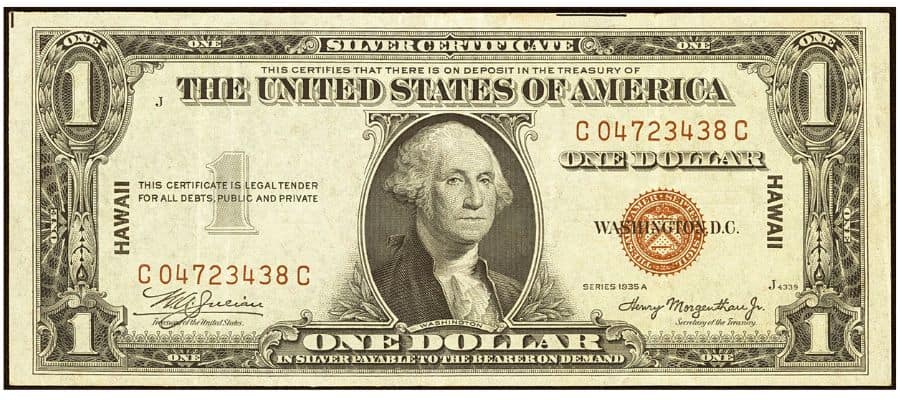
After the Pearl Harbor attack, the U.S. government ordered the Bureau of Engraving and Printing to issue the 1935 Hawaii overprint notes. The idea was if Japan occupied Hawaii and seized the U.S. dollars, the government could declare the overprint bills invalid.
Instead of the usual blue seal, these notes featured a brown seal and HAWAII stamp in small solid letters on the obverse and large letters on the reverse.
But what is its value?
Generally, 1935 $1 Hawaii notes bring in about $15 to $74 in circulated condition. For example, a $1 1935A Hawaii Silver certificate “short snorter” in very fine condition sold for $204 on June 20th, 2023.
If you have an uncirculated 1935A Hawaii note graded at MS-64 and above, expect around $126 to $833.
Like with North African notes, look for star notes and rare blocks. For Hawaii bills, the Federal Reserve produced about 204,000 pieces. These notes can cost between $200 and $270 in a circulated state.
In uncirculated conditions, collectors can pay as much as $2,0000 for notes with grades MS-63 and above. A collector paid $1,680 for such a note graded at MS-64 in 2021.
Let’s not forget about uncut sheets of Hawaii notes. These can fetch a higher price in auctions than individual pieces. For instance, a sheet of twelve notes graded at MS-63 sold for $5,405 in 2017 at Heritage Auctions.
4. 1935-A Experiment R and S Dollar Bill
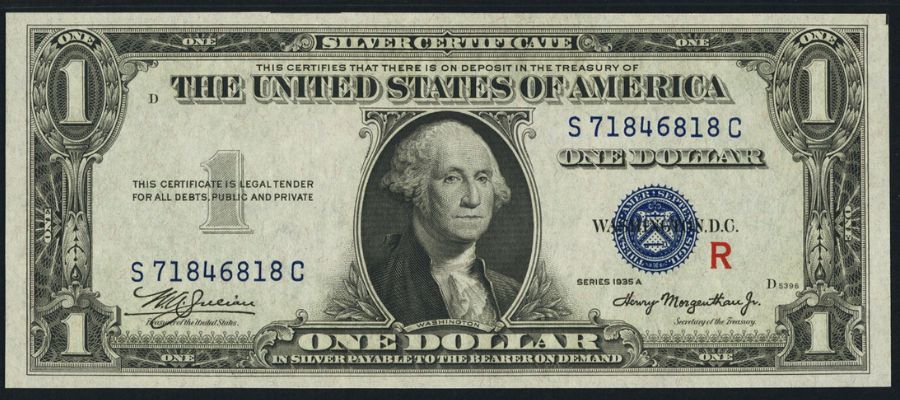
In the 1930s, the U.S. government wanted to improve the durability of their currency money and reduce their susceptibility to counterfeiting.
The 1935A series had almost 2.3 million experimental notes due to their use of alternative printing techniques and paper composition.
The Engraving Bureau used two different markings to tell apart notes printed on special paper from regular paper.
The replacement paper has a large red “S” mark on its obverse to signify it was special. Conversely, bills made from regular paper include a red “R” marking, meaning regular.
The 1935A experimental notes make up about 1% of all bills in the series. Because of this, they are considered rare.
Today, you can reserve a lot of both “R” and “S” 1935A experimental $1 silver certificate notes for $150 at Heritage Auctions. Such experimental pairs in very fine condition sold for $218.50 in 2009.
In uncirculated conditions, the value of the experimental R notes can reach $450 for bills with an MS–63 grade. In grades 65 to 67, the pieces can sell from $625 to $1,325.
In 2014, a 1935A R silver certificate graded at MS-67 brought in $1,762.50.
But before you buy an experimental note, look at the serial number on the bills. The reason is that an individual can stamp an R or S marking onto a regular 1935-A bill.
To find the legitimate “R” and “S” notes, look for these serial numbers:
- Red “R” serial number ranges: S70884001C–S72068000C
- Red “S” serial number ranges: S7384001C–S75068000C
1935-A Experiment R and S Star Note Dollar Bill
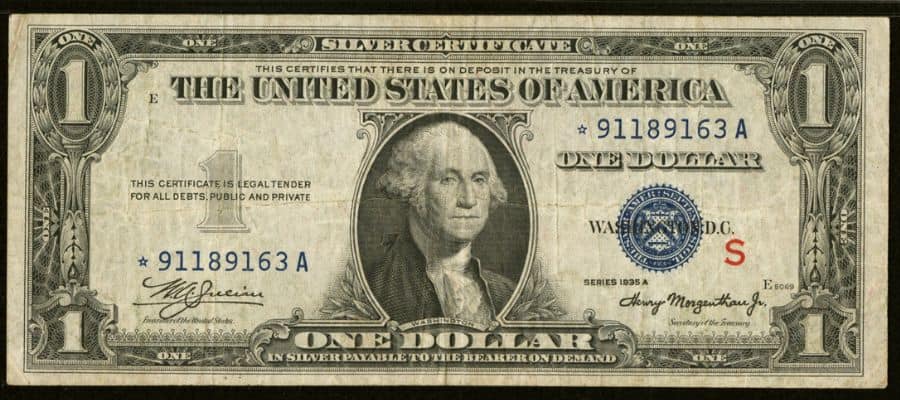
If you are lucky, you can score an experimental “R” or “S” star note. But only 12,000 were issued, so they are extremely rare.
A 1935A “S” silver certificate star in very fine condition can set you back $2,760. If you want a 1935A “R” star note in the same state, set aside around $3,000.
Uncirculated experimental star notes can fetch upwards of $15,000 in value. A good example is the uncirculated 1935A experimental “S” silver certificate star graded at MS-65 that sold for $13,800.
To ensure you find a legitimate experimental 1935A “R” or “S” star note, look for these serial numbers:
- Red “R” serial number ranges: *91176001A – *9118800A
- Red “S” serial number ranges: *91188001A – *91200000A
5. 1935-B Dollar Bill & 1935-C Dollar Bill
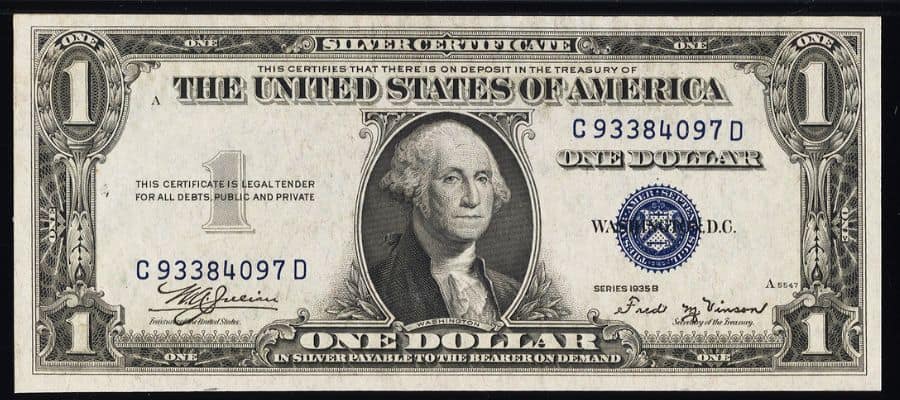
These two 1935 series notes have no significant differences in terms of design, but the B series bears Julian-Vinson signatures.
A circulated piece of 1935B silver certificate can cost anywhere from $5 to $8 in fine condition. But you can reserve such a piece ( from the M–D block) graded on MS-15 for $400 at Heritage Auctions.
An uncirculated sample in the C-D block can sell for as much as $129. But you can score more money with a star note. A 1935B silver certificate star note with MS-64 grade can sell for around $126 to $145.
On the other hand, an uncirculated 1935C silver certificate can cost at least $80.50. For the star note, you need about $144.
6. 1935-D Dollar Bill with Wide Border
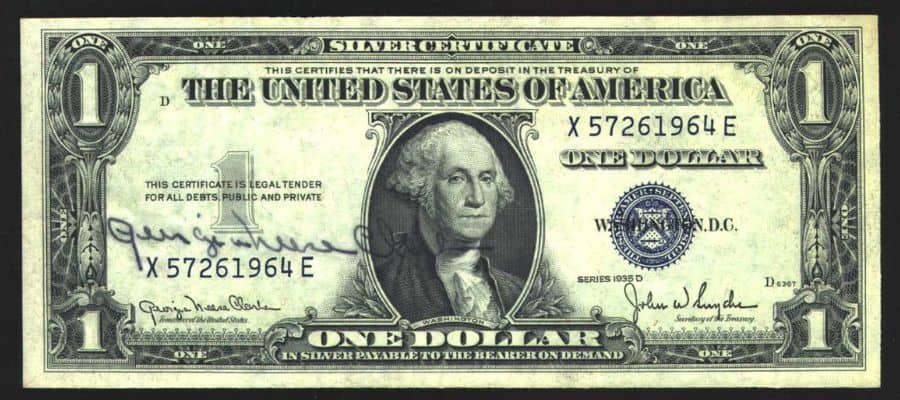
The 1935D features a wide border, almost double the green space on the top and bottom of the note.
This crisp circulated 1935D $1 silver certificate autographed by Georgia Neese Clark sold for $61.
7. 1935-D Dollar Bill with Narrow Border
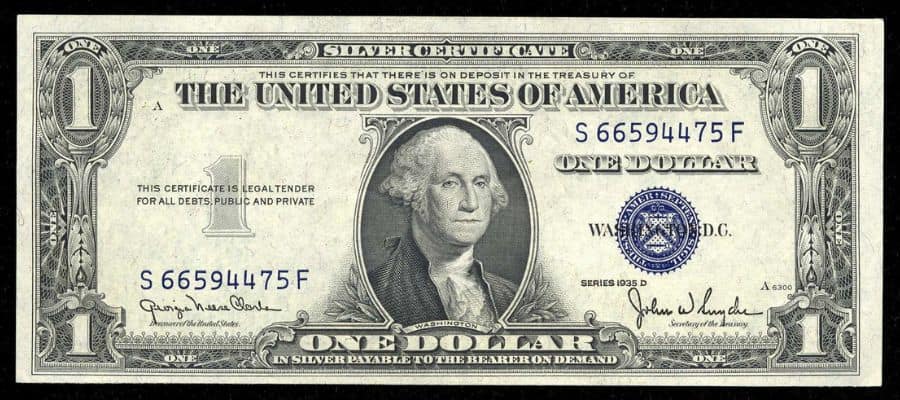
This 1935 series has a 3mm narrow border and features Clark-Synder signatures. Since the Federal Reserve printed billions of 1935D narrow border bills, most cost no more than their face value. However, some unique pieces can fetch a premium in Auctions.
Oftentimes, the 1935D narrow border is sold as a pair with 1935D wide border silver certificate. A pair of crisp uncirculated notes can sell anywhere from $57 to $299.
8. 1935-E Dollar Bill
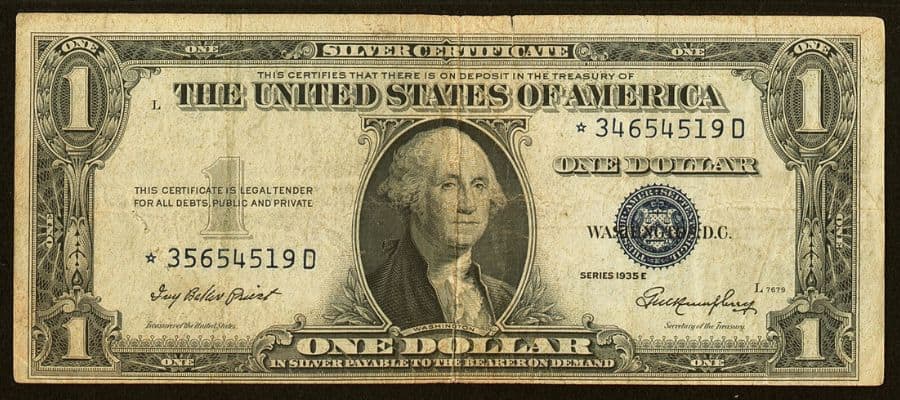
The 1935E silver certificate is highly sought after by collectors because the series has some errors, serial numbers, and varieties that make it valuable.
For example, an uncirculated 1935E dollar bill graded at MS-64 with a missing back printing error sold for $2,520. Another great example is a 1935E with a mismatched serial number error, which brought in about $780.
1935 Dollar Bill Unique Errors
With 1935-dollar bill varieties out of the way, it’s time to explore the various distinct errors associated with these silver certificates. Let’s start with mule notes.
1. 1935 $1 Mule Note
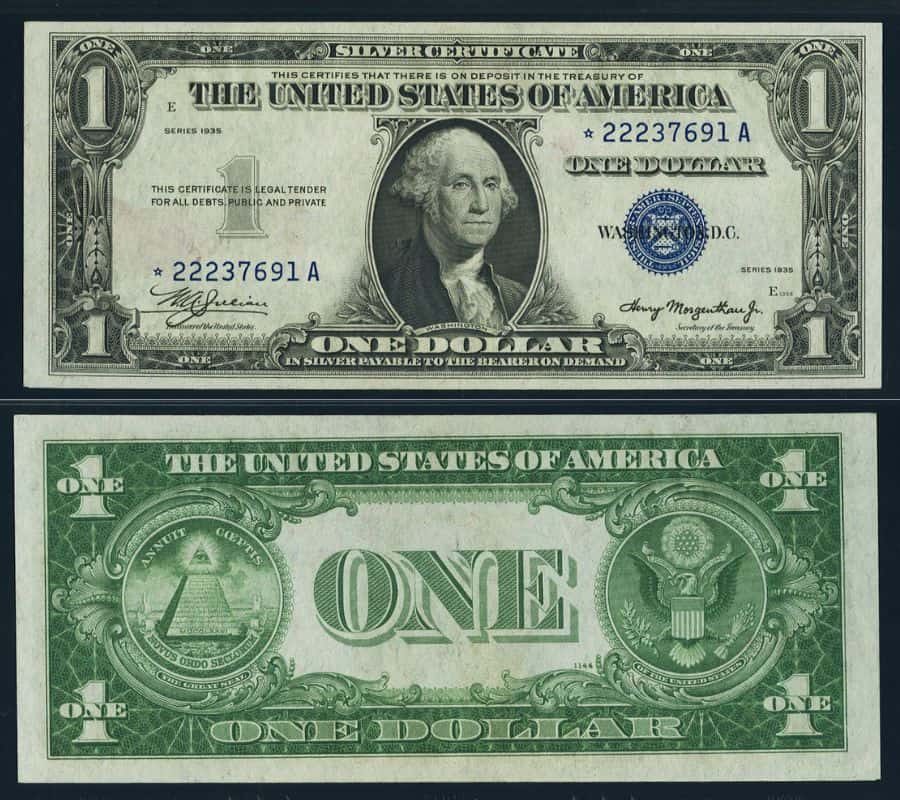
Mule notes appear when the Bureau of Engraving and Printing uses different printing plates for the obverse and reverse of the bill. This printing mistake resulted in a rare note with mismatched serial numbers on the front and the back.
Most currency collectors will pay vast sums of money for these rare pieces. As a fact, a collector paid $10,800 for a 1935 Mule silver certificate graded at MS–65 in 2018. A similar sample with MS–64 grade sold for $4,320 in 2021.
2. 1935 Dollar Bill Obstructed Overprint with BEP Rejection Mark
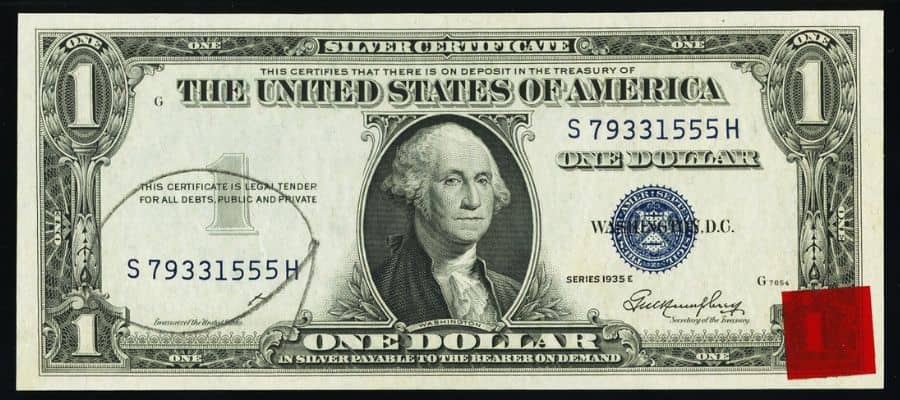
An obstructed overprint on a note means the overprinting press was unable to put design elements on the front of it, creating a silver certificate. This results in a note with a blank or partial blank section.
As for the BEP Rejection mark, it’s a sticker, stamp, or line that the Bureau of Engraving and Printing places on defective notes. The markings help them identify and remove the bills before they enter circulation.
However, some defective notes can reach the public. One example is the 1935E silver certificate with a partially obstructed overprint error and BEP rejection sticker sold for $312 in 2020.
3. 1935 Dollar Bill with Inverted M in Prefix
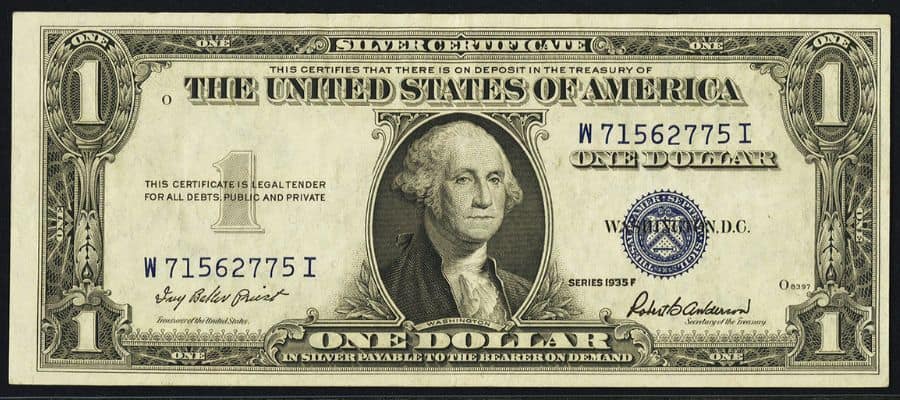
As the name suggests, this error note comes with an inverted “M” letter in the right serial number. The error happens when the M letter is placed upside down in the serial numbering wheel prefix letter slot.
You can check out an example of a 1935F silver certificate with an inverted “M” prefix letter at Heritage Auctions’ official site. While we can’t estimate the correct value of these error notes, we are positive collectors will pay lots of money for them.
4. 1935 Star Notes with Inverted Star
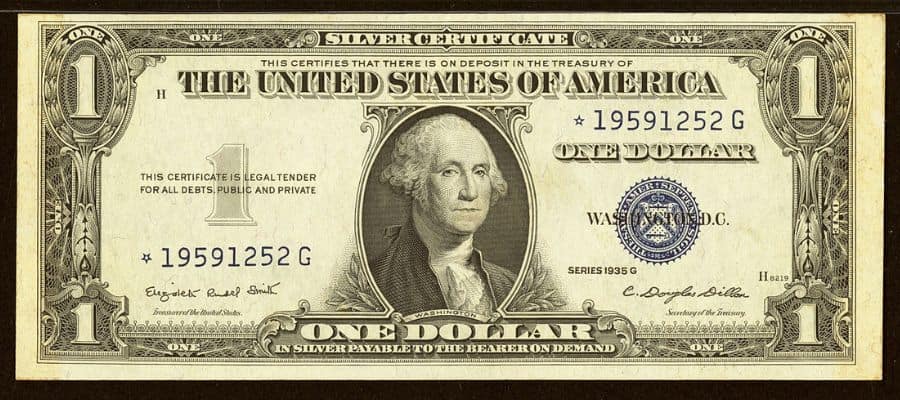
In this note, the star symbol appears upside down in the right serial number. It’s super rare and can set you back thousands of dollars.
Here’s an example of a 1935G silver certificate with an inverted star error. It’s currently selling for $750.
5. 1935 Dollar Bill Printed Fold-over Error
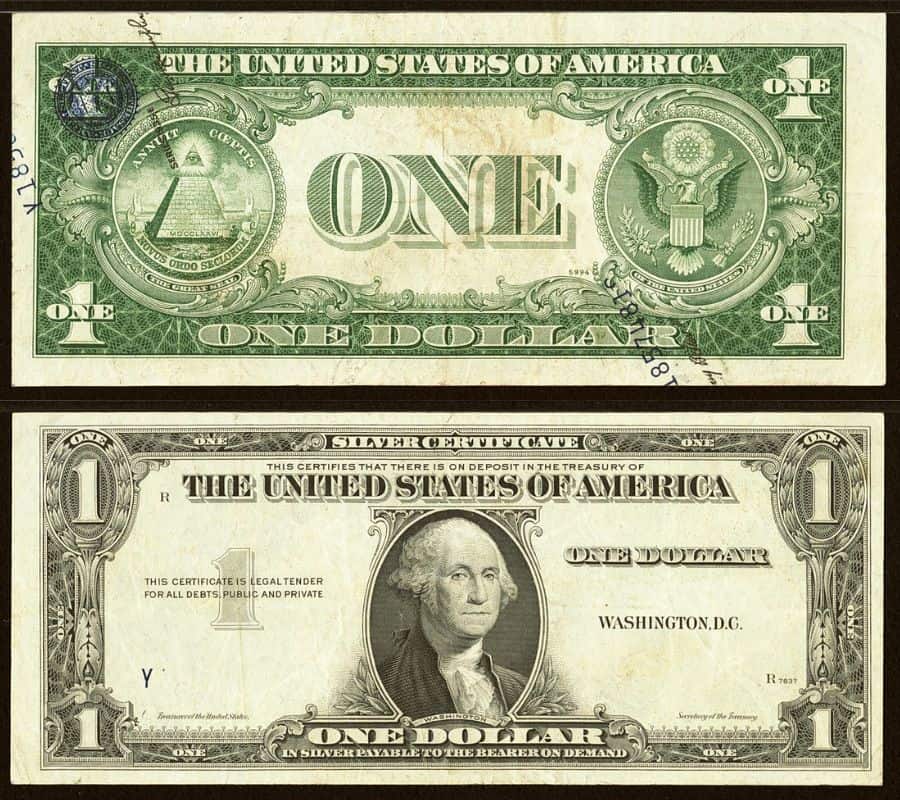
Here’s another accidental printing error that occurs when a sheet of paper is folded before or during the process.
Most 1935 silver certificate errors appear to miss a part of their design or are distorted on one side of both sides. The value of these error notes depends on the location and severity of the Fold over.
According to ha.com, the most expensive 1935 dollar note with a printed foldover sold for over $4,000 in May 2023.
6. 1935 Dollar Bill Inverted Back Error
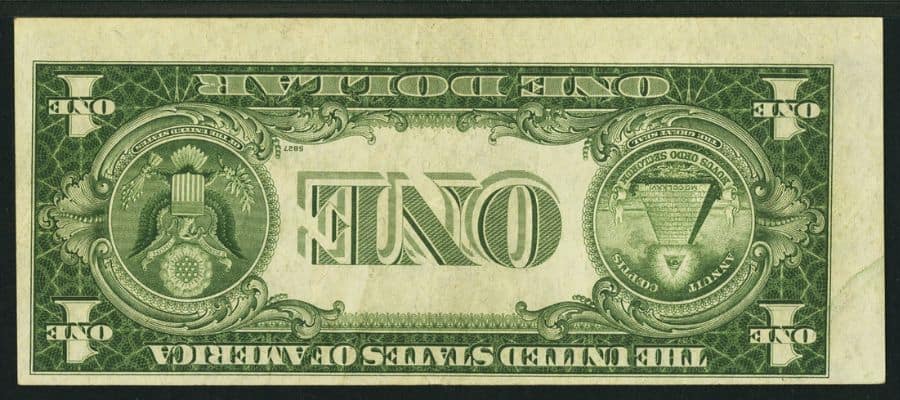
A 1935 dollar note with an inverted back error occurs when the front and back of the bill are accidentally printed in the opposite orientation. The paper money usually appears with the top of the obverse being aligned with the bottom of the reverse, or vice versa.
These error notes can sell for more than $900 in auctions.
7. 1935 Silver Certificate Partial Reverse Printing Missing Error
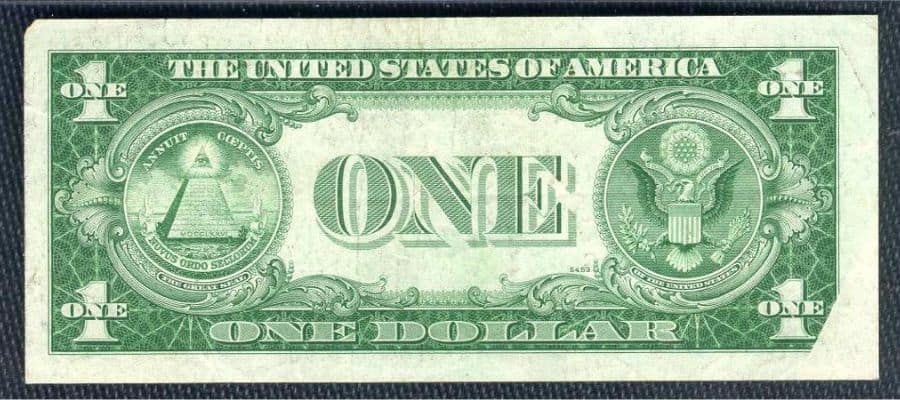
This error occurs when the printing press malfunction or the printing department uses defective paper, resulting in a bill with a partially blank reverse. Because of this unique defect, notes with this error demand a higher price than regular notes.
Here’s an example of the error note that sold for $21 in 2000.
8. 1935 Dollar Bill Inverted Third Printing Error
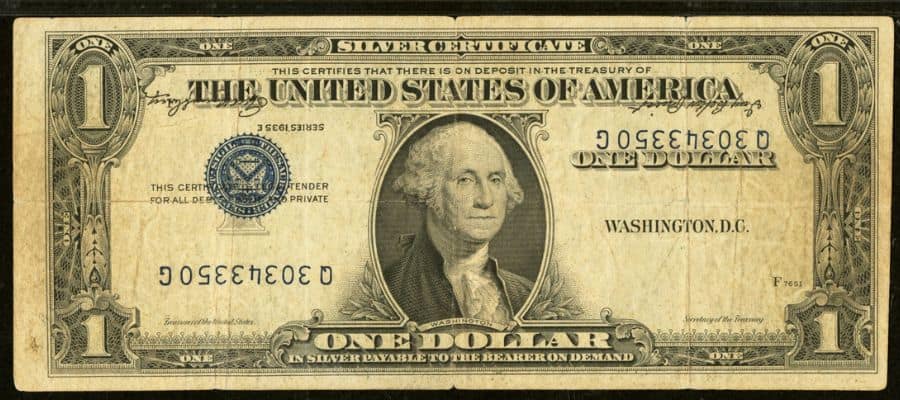
A 1935 one-dollar with this error features inverted serial numbers, seal, signatures, and series date on the front side.
Like most errors, this one occurs when the sheet of paper is not aligned properly in the overprint press. These notes can sell for as much as $150 or more.
For instance, a paper money enthusiast paid $228 for a 1935E silver certificate with inverted third printing errors on 12th 2023.
Closing Thoughts
As we wrap up, it’s clear the 1935 silver certificate $1 note is a valuable piece of bill to have. While most only go for $1, some distinct varieties and errors can make them extremely valuable. So, be on the lookout for these bills.
Based on our research, 1935-dollar notes in average condition typically sell for about $3 to $10. If it’s a star note, the note’s value could increase to $12. For uncirculated pieces, expect them to bring you up to $200 or $1000 in higher grades.
That said, we had fun researching everything about this unique piece, from its history to its value. But if you feel we’ve missed some critical information, let us know in the comment section below.
Happy collecting!
